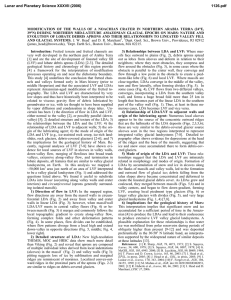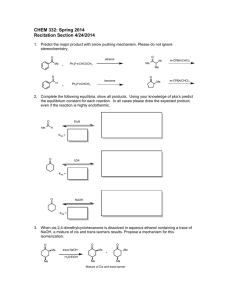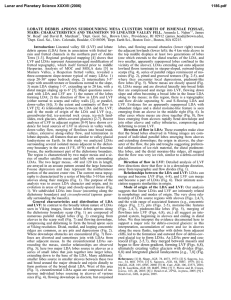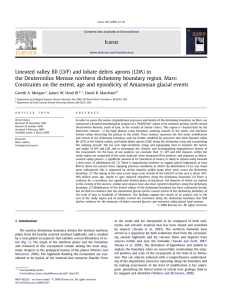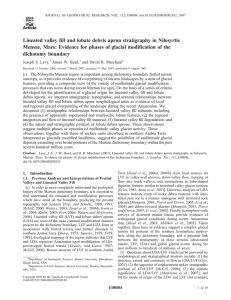FLOW PATTERNS OF LOBATE DEBRIS APRONS AND LINEATED VALLEY FILL... ISMENIAE FOSSAE, MARS. , J. W. Head , and D. R. Marchant
advertisement
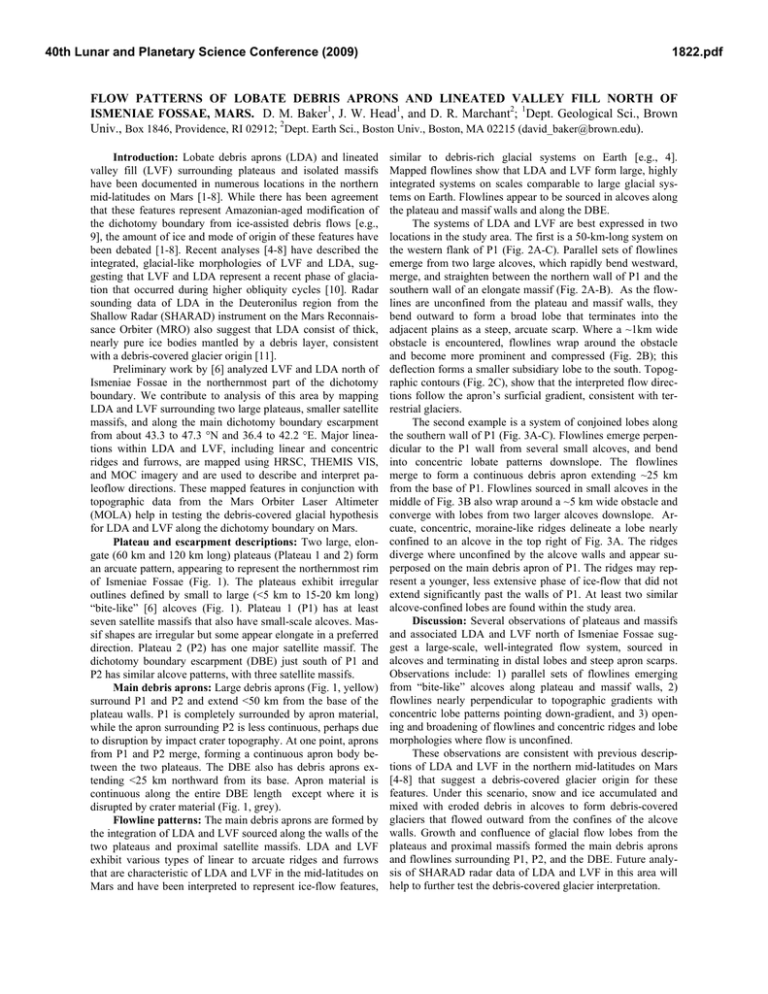
40th Lunar and Planetary Science Conference (2009) 1822.pdf FLOW PATTERNS OF LOBATE DEBRIS APRONS AND LINEATED VALLEY FILL NORTH OF ISMENIAE FOSSAE, MARS. D. M. Baker1, J. W. Head1, and D. R. Marchant2; 1Dept. Geological Sci., Brown Univ., Box 1846, Providence, RI 02912; 2Dept. Earth Sci., Boston Univ., Boston, MA 02215 (david_baker@brown.edu). Introduction: Lobate debris aprons (LDA) and lineated valley fill (LVF) surrounding plateaus and isolated massifs have been documented in numerous locations in the northern mid-latitudes on Mars [1-8]. While there has been agreement that these features represent Amazonian-aged modification of the dichotomy boundary from ice-assisted debris flows [e.g., 9], the amount of ice and mode of origin of these features have been debated [1-8]. Recent analyses [4-8] have described the integrated, glacial-like morphologies of LVF and LDA, suggesting that LVF and LDA represent a recent phase of glaciation that occurred during higher obliquity cycles [10]. Radar sounding data of LDA in the Deuteronilus region from the Shallow Radar (SHARAD) instrument on the Mars Reconnaissance Orbiter (MRO) also suggest that LDA consist of thick, nearly pure ice bodies mantled by a debris layer, consistent with a debris-covered glacier origin [11]. Preliminary work by [6] analyzed LVF and LDA north of Ismeniae Fossae in the northernmost part of the dichotomy boundary. We contribute to analysis of this area by mapping LDA and LVF surrounding two large plateaus, smaller satellite massifs, and along the main dichotomy boundary escarpment from about 43.3 to 47.3 °N and 36.4 to 42.2 °E. Major lineations within LDA and LVF, including linear and concentric ridges and furrows, are mapped using HRSC, THEMIS VIS, and MOC imagery and are used to describe and interpret paleoflow directions. These mapped features in conjunction with topographic data from the Mars Orbiter Laser Altimeter (MOLA) help in testing the debris-covered glacial hypothesis for LDA and LVF along the dichotomy boundary on Mars. Plateau and escarpment descriptions: Two large, elongate (60 km and 120 km long) plateaus (Plateau 1 and 2) form an arcuate pattern, appearing to represent the northernmost rim of Ismeniae Fossae (Fig. 1). The plateaus exhibit irregular outlines defined by small to large (<5 km to 15-20 km long) “bite-like” [6] alcoves (Fig. 1). Plateau 1 (P1) has at least seven satellite massifs that also have small-scale alcoves. Massif shapes are irregular but some appear elongate in a preferred direction. Plateau 2 (P2) has one major satellite massif. The dichotomy boundary escarpment (DBE) just south of P1 and P2 has similar alcove patterns, with three satellite massifs. Main debris aprons: Large debris aprons (Fig. 1, yellow) surround P1 and P2 and extend <50 km from the base of the plateau walls. P1 is completely surrounded by apron material, while the apron surrounding P2 is less continuous, perhaps due to disruption by impact crater topography. At one point, aprons from P1 and P2 merge, forming a continuous apron body between the two plateaus. The DBE also has debris aprons extending <25 km northward from its base. Apron material is continuous along the entire DBE length except where it is disrupted by crater material (Fig. 1, grey). Flowline patterns: The main debris aprons are formed by the integration of LDA and LVF sourced along the walls of the two plateaus and proximal satellite massifs. LDA and LVF exhibit various types of linear to arcuate ridges and furrows that are characteristic of LDA and LVF in the mid-latitudes on Mars and have been interpreted to represent ice-flow features, similar to debris-rich glacial systems on Earth [e.g., 4]. Mapped flowlines show that LDA and LVF form large, highly integrated systems on scales comparable to large glacial systems on Earth. Flowlines appear to be sourced in alcoves along the plateau and massif walls and along the DBE. The systems of LDA and LVF are best expressed in two locations in the study area. The first is a 50-km-long system on the western flank of P1 (Fig. 2A-C). Parallel sets of flowlines emerge from two large alcoves, which rapidly bend westward, merge, and straighten between the northern wall of P1 and the southern wall of an elongate massif (Fig. 2A-B). As the flowlines are unconfined from the plateau and massif walls, they bend outward to form a broad lobe that terminates into the adjacent plains as a steep, arcuate scarp. Where a ~1km wide obstacle is encountered, flowlines wrap around the obstacle and become more prominent and compressed (Fig. 2B); this deflection forms a smaller subsidiary lobe to the south. Topographic contours (Fig. 2C), show that the interpreted flow directions follow the apron’s surficial gradient, consistent with terrestrial glaciers. The second example is a system of conjoined lobes along the southern wall of P1 (Fig. 3A-C). Flowlines emerge perpendicular to the P1 wall from several small alcoves, and bend into concentric lobate patterns downslope. The flowlines merge to form a continuous debris apron extending ~25 km from the base of P1. Flowlines sourced in small alcoves in the middle of Fig. 3B also wrap around a ~5 km wide obstacle and converge with lobes from two larger alcoves downslope. Arcuate, concentric, moraine-like ridges delineate a lobe nearly confined to an alcove in the top right of Fig. 3A. The ridges diverge where unconfined by the alcove walls and appear superposed on the main debris apron of P1. The ridges may represent a younger, less extensive phase of ice-flow that did not extend significantly past the walls of P1. At least two similar alcove-confined lobes are found within the study area. Discussion: Several observations of plateaus and massifs and associated LDA and LVF north of Ismeniae Fossae suggest a large-scale, well-integrated flow system, sourced in alcoves and terminating in distal lobes and steep apron scarps. Observations include: 1) parallel sets of flowlines emerging from “bite-like” alcoves along plateau and massif walls, 2) flowlines nearly perpendicular to topographic gradients with concentric lobe patterns pointing down-gradient, and 3) opening and broadening of flowlines and concentric ridges and lobe morphologies where flow is unconfined. These observations are consistent with previous descriptions of LDA and LVF in the northern mid-latitudes on Mars [4-8] that suggest a debris-covered glacier origin for these features. Under this scenario, snow and ice accumulated and mixed with eroded debris in alcoves to form debris-covered glaciers that flowed outward from the confines of the alcove walls. Growth and confluence of glacial flow lobes from the plateaus and proximal massifs formed the main debris aprons and flowlines surrounding P1, P2, and the DBE. Future analysis of SHARAD radar data of LDA and LVF in this area will help to further test the debris-covered glacier interpretation. 40th Lunar and Planetary Science Conference (2009) References: [1] Sharp, R.P. (1973) J. Geophys. Res., 78, 20, 4,0734,083. [2] Squyres, S.W. (1978) Icarus, 34, 600-613. [3] Lucchitta, B.K. (1984) J. Geophys. Res., 89, 409-418. [4] Head et al. (2006) Earth Planet. Sci. Lett., 241, 663-671. [5] Head et al. (2006) Geophys. Res. Lett., 33, L08S03, doi:10.1029/2005GL024360. [6] Nahm, A.L. and J.W. Head (2006) LPSC 37, Abs. #1189. [7] Levy, J.S. (2007) J. Geophys. Res., 112, E08004, doi:10.1029/2006JE002852. [8] Dickson, J.L. et al. (2008) Geology, 36, 5, 411-414, doi:10.1130/G24382A.1. [9] McGill, G.E. (2000) J. Geophys. Res., 105, E3, 6,945-6,959. [10] Head et al. (2003) Nature, 426, 797-802. [11] Plaut, J.J. et al. (2008) Geophys. Res. Lett., in press, doi:10.1029/2008GL036379. 1822.pdf A Fig 2 P1 Fig. 3 P2 B DBE Fig. 1. Map of plateaus (P1 and P2, red), massifs (pink), and dichotomy boundary escarpment (DBE, red) and associated main debris aprons (yellow) north of Ismeniae Fossae (centered at 45°N, 39°E). Flowlines are drawn as black lines and arrows show interpreted flow directions. Other colors: crater floor material (light grey), crater wall (dark grey), hummocky plains (patterned), plains material (light green). A B C Fig. 2. Integrated nature of LDA and LVF west of P1 (inset, Fig. 1). (A) HRSC image (orbit 1622), (B) inset of Fig. 1 showing mapped flowlines and interpreted flow directions (arrows), (C) MOLA derived contours (50 m interval) and interpreted flow directions. C Fig. 3. Integrated nature of LDA lobes south of P1. (A) HRSC image (orbit 1622), (B) inset of Fig. 1 showing mapped flowlines and interpreted flow directions (arrows), (C) MOLA derived contours (50 m interval) and interpreted flow directions.


